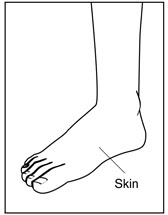Make sure the water is not hot by testing the temperature along with your elbow. Do not soak your feet. Dry your feet well, between your toes.
Look at your feet every day to check for cuts, sores, blisters, redness, calluses, or other problems:
Checking every day is even more important in case you have nerve destroy or poor blood flow. In case you cannot bend over or pull your feet up to check them, use a mirror. In case you cannot see well, ask somebody else to check your feet.
If your skin is dry, rub lotion on your feet after you wash and dry them: Do not put lotion between your toes.
File corns and calluses gently with an emery board or pumice stone: Drawing of a nail clipper and an emery board. Do this after your bath or shower.
Cut your toenails once a week or when needed:
Cut toenails when they are soft from washing. Cut them to the shape of the toe & not short. File the edges with an emery board.
Always wear slippers or shoes to protect your feet from injuries.
Always wear socks or stockings to avoid blisters:
Do not wear socks or knee-high stockings that are tight below your knee.
Wear shoes that fit well:
Shop for shoes at the finish of the day when your feet are bigger. Break in shoes slowly. Wear them one to two hours each day for the first few weeks.
Before putting your shoes on, feel the insides to make sure they have no sharp edges or objects that might injure your feet.









































